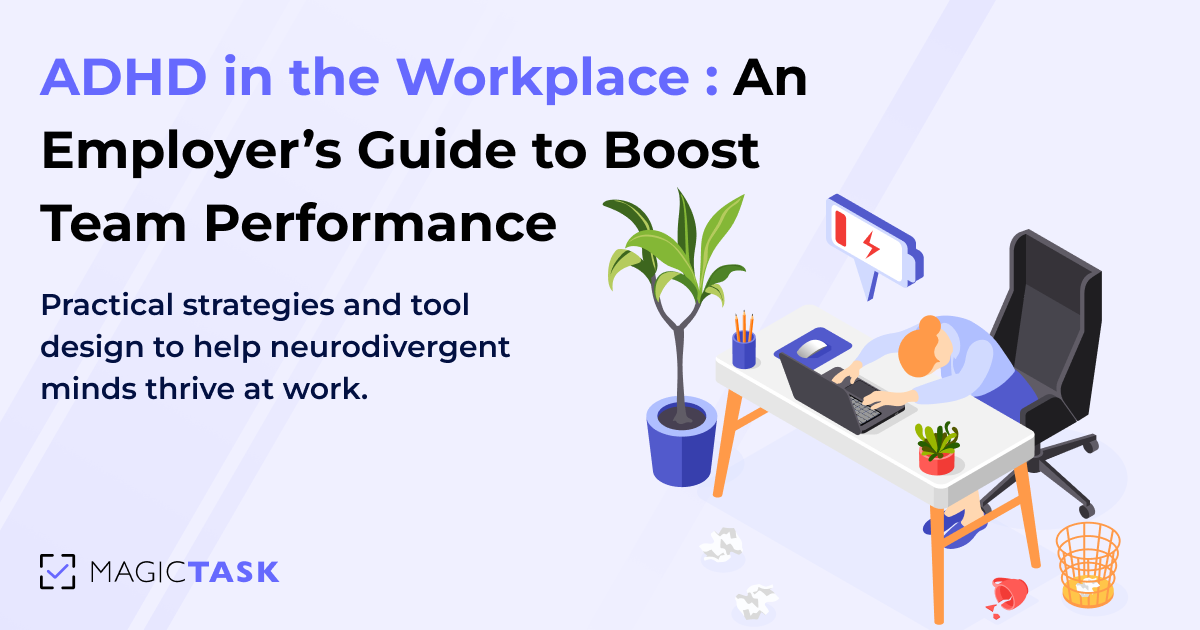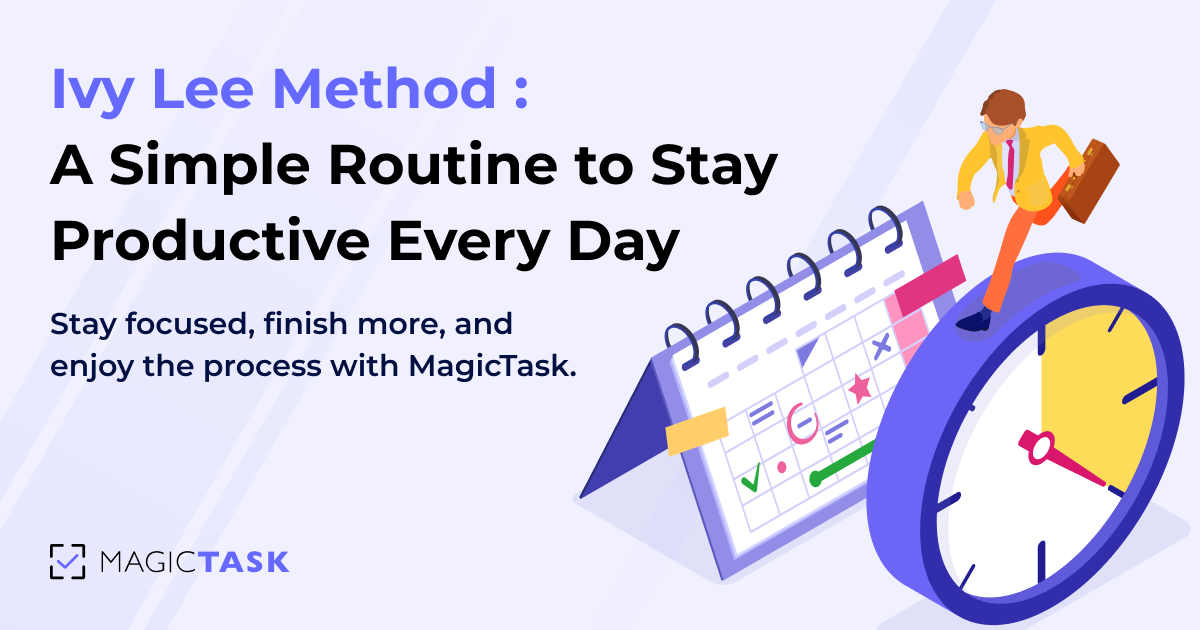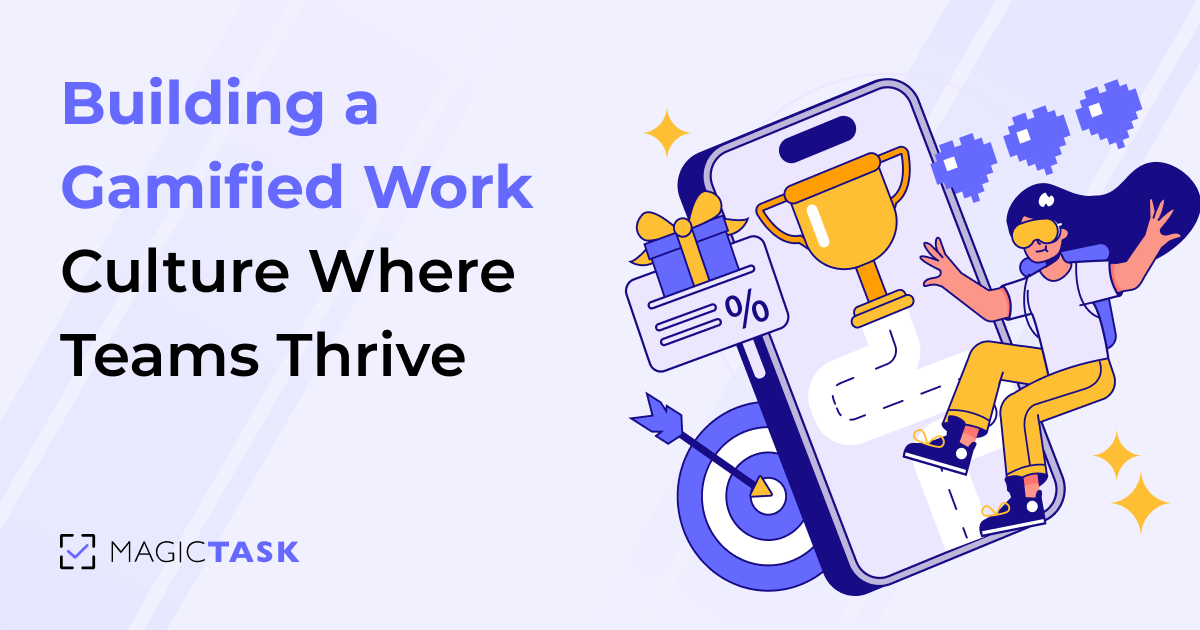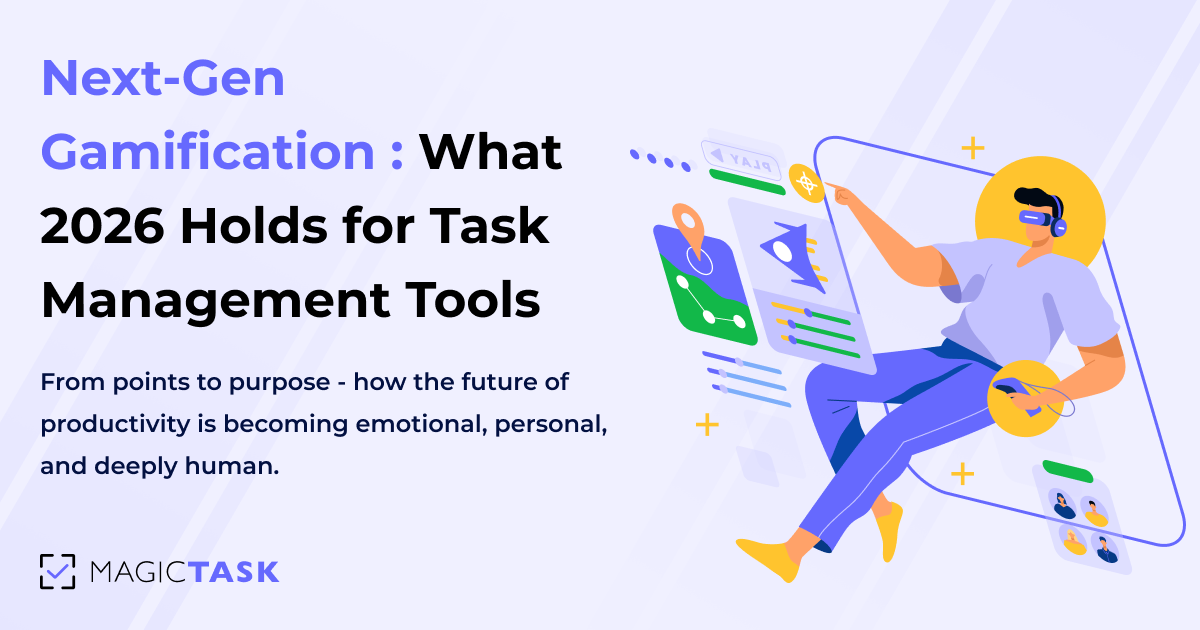The Real Reason You Procrastinate – And How to Start Getting Things Done

You glance at your to‑do list and feel your heartbeat spike. But instead of completing tasks and checking them off the list, you say, “Maybe later”.
Does that sound familiar?
If that scenario hits home, you’re experiencing the classic tug‑of‑war between your limbic system’s craving for instant comfort and your prefrontal cortex’s push for long‑term progress.
And you’re far from alone.
Studies show that 20–25% of adults classify themselves as chronic procrastinators, meaning millions of us face the same feeling.
So let's try understanding the real, science-backed reasons why we procrastinate and discuss strategies to get unstuck.
So, let’s get started.
The Real Reason You Procrastinate
Before we get to the reason why we procrastinate, let’s get something clear. Procrastination isn’t a sign of laziness or a lack of willpower, but an emotional avoidance strategy.
It kicks in whenever a task feels:
- Overwhelming, when you’re staring at a blank page, wondering where even to begin
- Ambiguous, when vague instructions leave you unsure what “update the report” actually means
- Boring, when repetitive data entry makes you question why you bothered
- Threatening, when the fear of failure or criticism stops you in your tracks
When you’re feeling all these feelings, your brain is torn between listening to the limbic system and the prefrontal cortex.
That’s what leads to the reasons for procrastination.
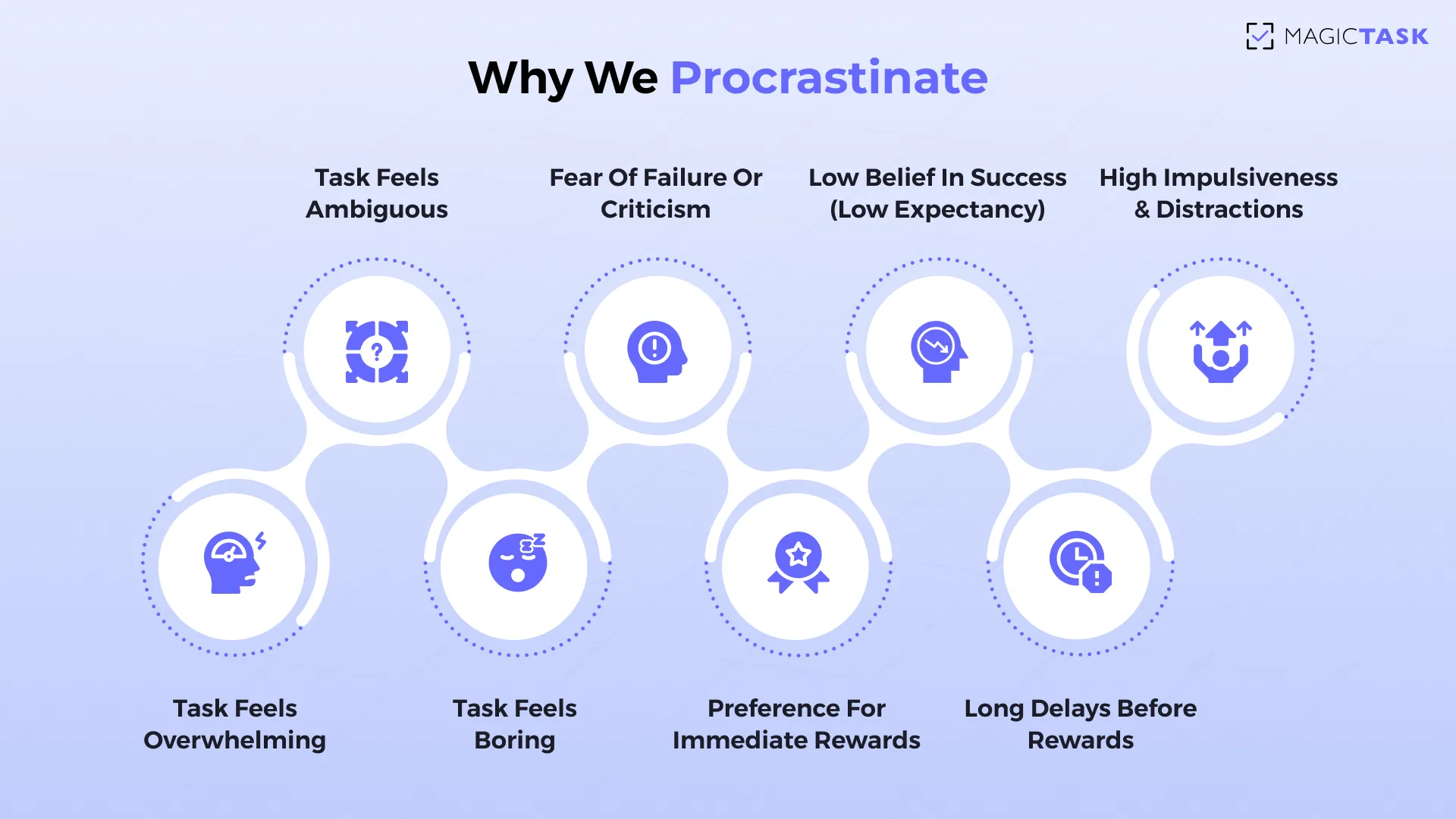
Limbic Hijack
When your brain senses a task as uncomfortable, your threat‑detector (the amygdala) kicks into high gear.
This “limbic hijack” floods your system with stress hormones and a craving for relief, and suddenly, the closest source of comfort, like social media, snacks, or busy work, feels far more appealing than the real work at hand.
While your emotional center screams “avoid,” the prefrontal cortex—the part of your brain that plans, reasons, and wills itself forward—takes a back seat.
Scrolling through your feed or reorganizing your desktop triggers small hits of dopamine and reinforces avoidance, so every time you try to focus, your brain nudges you back toward the “easier” reward.
But it is only half the story; our brain’s reward system also tilts the scales toward bias.
Dopamine & Delay Discounting
Your midbrain dopamine neurons respond to any hint of reward, especially when it’s right in front of you.
Neuroscientists have shown that these neurons light up not only when you actually receive a treat, but even when you expect one, turning anticipation itself into a tiny hit of pleasure.
But the farther away a reward lies, the smaller that dopamine surge becomes.
This “delay discounting” means your brain devalues tomorrow’s big achievement in favor of today’s quick payoff.
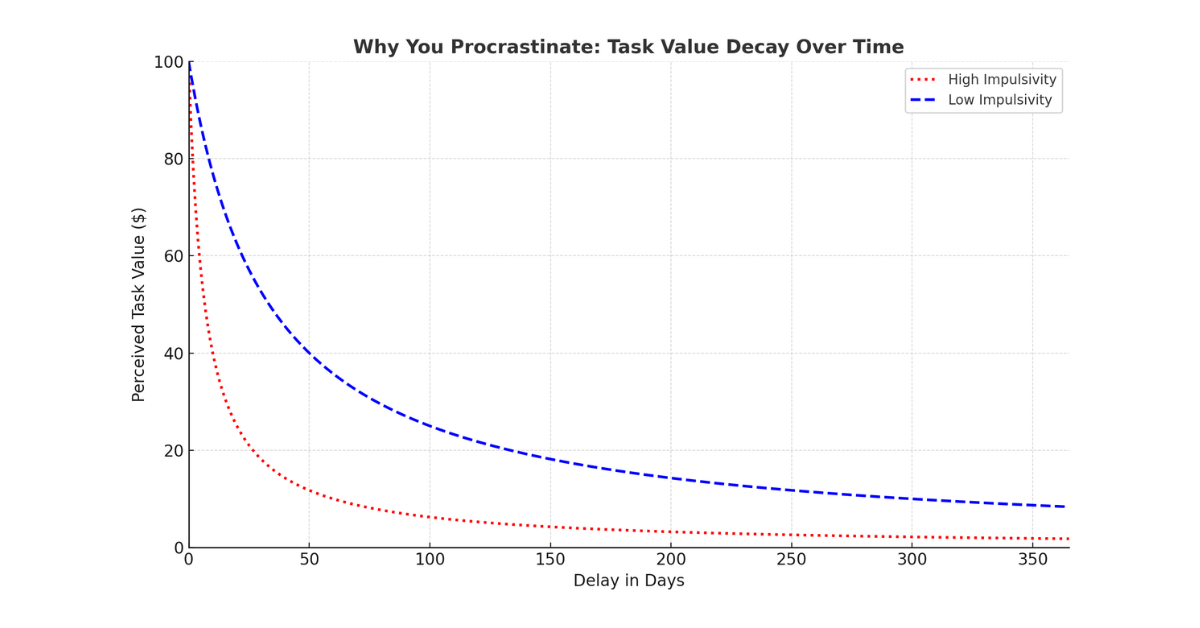
In practice, this is why you’ll find yourself breezing through a five‑minute email response while balking at a two‑hour market analysis that won’t pay off until next quarter.
Temporal Motivation Theory
While dopamine surges and delay discounting show us what happens in the brain when we procrastinate, Temporal Motivation Theory (TMT) explains why certain tasks get sidelined and others tackled head‑on.
Developed by Piers Steel and Cornelius König, TMT distills motivation into a simple equation:
Motivation = (Expectancy × Value) / (1 + Impulsiveness × Delay)
Where,
- Expectancy is your belief that you can succeed.
- Value is how rewarding you perceive the outcome to be.
- Delay is the time until the reward arrives.
- Impulsiveness reflects how much immediate comforts tempt you.
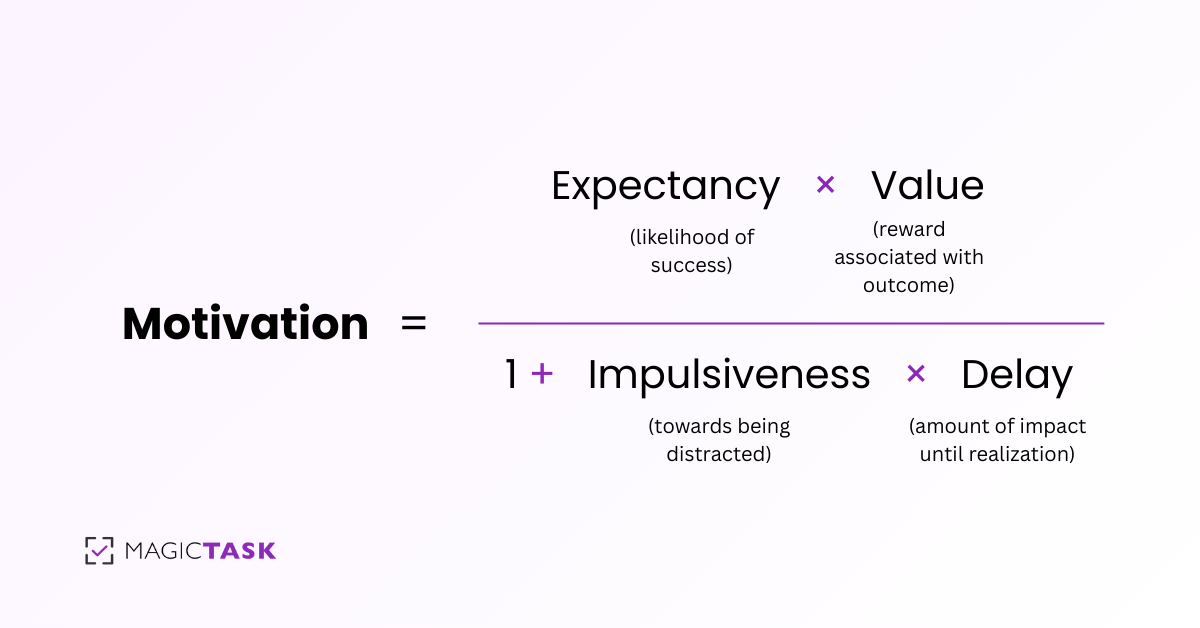
Imagine you have two tasks: writing next month’s annual report (high value, valuable to your career, but due in four weeks) versus drafting a five‑sentence email reply (low value, due immediately).
TMT predicts you’ll gravitate toward the email because the delay is minimal and impulsiveness drives you toward that quick win, even though the report may be far more critical.
What does it mean for procrastination?
- Long delays and low expectancy crush motivation.
- High‑value tasks still languish if they feel distant or too complex.
- People with higher impulsiveness give in to distractions more easily.
By understanding TMT, you realize procrastination isn’t a moral failing, but a predictable outcome of our brain’s time‑sensitive calculus.
And once you know the formula, you can hack it and watch motivation take over.
Breaking free from procrastination means interrupting the cycle before it tightens its grip.
Procrastination Is a Cycle — Here’s What It’s Doing to You
When you delay, you’re not just pushing a task off your plate. You’re stacking stress on top of stress.
Did you know that the average person spends nearly 55 days a year — that’s almost two months — delaying essential tasks.
Over time, the habit loop of avoidance starts to erode your ability to accomplish things.
Here’s precisely what happens:
- Mental load buildup: Each postponement makes the task feel more daunting, so it becomes even harder to start next time.
- Lower self‑trust: You miss commitments, and that chips away at your confidence in your follow‑through.
- Missed deadlines and opportunities: Trying to wait until the last minute often means you miss the window to deliver your best work or even deliver at all.
- Increased stress and guilt: Anxiety grows as due dates loom, and guilt sets in the moment you realize how much you’ve fallen behind.
- Declining performance: You try to keep up, but rushed efforts lead to avoidable errors, reinforcing the belief that “I work better under pressure,” which only fuels more delay.
Let’s take the example of a product manager I worked with. By putting off stakeholder updates until the day before presentations, she repeatedly found herself scrambling for accurate data, burning out her team, and watching decision‑makers grow frustrated.
What began as a few skipped emails turned into a habit loop that threatened her credibility and her project’s success.
Breaking free means interrupting this cycle before it tightens its grip, which brings us to the five proven ways to break free from the procrastination cycle.
Five Quick Ways to Start Getting Things Done
Now that you’ve seen how delaying just one task can snowball into missed deadlines, stress, and eroded confidence, it’s time to shift gears from “maybe later” to “done now.”
1. Break Tasks into Micro-Steps
When you face a project that feels enormous—say, “Finish the Q3 marketing presentation”—your brain balks.
That single directive demands dozens of decisions all at once, such as which slides you need, what data to include, and which design to choose. It’s no wonder we freeze or detour into something else, thinking that the task is abstract.
The antidote is to carve out the very first slice of the work.
Instead of “Finish presentation,” you might define your opening move as “Draft three talking points for the introduction.”
That tiny commitment takes less than two minutes and fits squarely within your brain’s comfort zone. You’re no longer wrestling the whole elephant. You’re merely petting its ear.
That one small win triggers a dopamine release, clears mental bandwidth, and gives you the confidence to tackle the next micro‑step.
You can use tools like MagicTask to find the starting point.
In MagicTask, each micro-step is its own item, sized “S, M, L, or XL”, so you can visualize exactly where to begin depending on the task size. Drag that smallest task into your “My Focus” lane, complete it, and feel the forward pull of genuine progress.
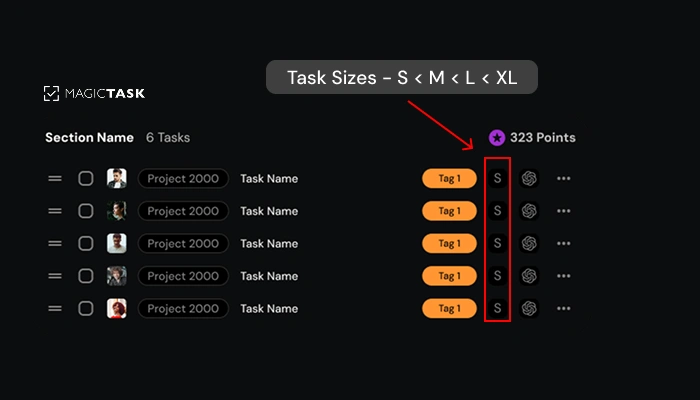
That initial win wakes your momentum, so why stop there? Turn every small task into a “do it now” move.
2. Use the Two-Minute Rule
A general rule of thumb to avoid procrastination is to stop adding things to your to-do list.
If a task can be done in under two minutes, do it immediately.
The Two-Minute Rule is rooted in cognitive load theory.
Your brain is juggling dozens of open loops, like emails to send, forms to fill out, and quick replies. Each one adds mental friction.
Every time you defer a tiny task, it lingers in your working memory and steals precious attention from the work that matters.
By knocking out those under‑two‑minute actions on the spot, you declutter your mind and free up bandwidth for deeper work.
For example, instead of letting that notification about confirming your team’s lunch order sit unread, you tap “yes” right away. That single click clears a mental nag and delivers a minor dopamine hit that reinforces “action = relief.”
As Nelson Mandela says, “It always seems impossible until it’s done.” You just have to put your mind to it.
3. Try the Pomodoro Technique
Now, that was about the small tasks, but what about when the bigger tasks stall you? That’s where the Pomodoro Technique steps in.
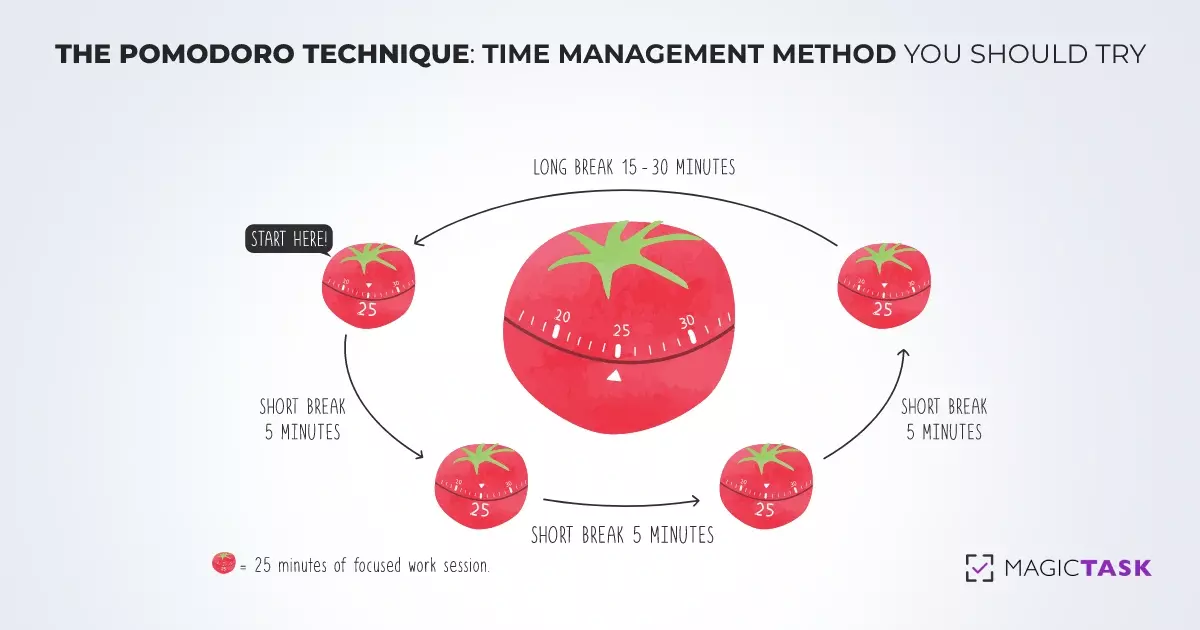
By breaking your day into bite‑sized sprints, it tricks your brain into sustained focus and permits you to rest before fatigue can set in.
Here’s how it works:
- 25‑Minute Focus Sprint: Work on one straightforward, specific task—no email, no social media, no side quests. That finite window feels less intimidating than “work until you’re done.”
- 5‑Minute Recharge: Step away to stretch, hydrate, or simply glance out the window. This brief pause helps reset your mental energy and maintain peak performance.
- Repeat & Recover: After four Pomodoros, take a longer break (15–30 minutes). This deeper rest replenishes your willpower and wards off burnout.
The Pomodoro Technique clicks because it lowers the barrier to starting a task. Telling yourself you only need to work for 25 minutes makes even your most dreaded tasks feel manageable.
Each completed sprint delivers a mini‑victory that builds unstoppable momentum. That surge is powerful, but to keep it rolling, begin each Pomodoro with an action so easy it barely registers as work.
4. Start with a Low-Resistance Action
Sometimes the most challenging part is simply getting started.
When you stare at a blank page or an empty spreadsheet, your brain sees a vast expanse of unknowns—and it won’t step into that territory without a compelling reason.
That’s where a low‑resistance action can be helpful.
You choose the single smallest, least threatening step you can imagine, like opening the file and typing one sentence. That way, you drastically reduce the “activation energy” your brain demands before it gets to work.
Psychologist Bluma Zeigarnik first observed in the 1920s that we often obsess over unfinished tasks and feel a psychological itch until they are completed.
That itch is your brain craving closure. When you give it a nibble—a one‑sentence start or a single chart in a deck—you satisfy the initial craving and spark the momentum that carries you forward.
Over time, these tiny openings break the procrastination loop and train your mind to expect progress.
5. Don’t Aim for Perfect — Aim for Progress
Perfectionism often disguises itself as thoroughness, yet it can be just as paralyzing as procrastination.
When every decision hinges on achieving an ideal outcome, projects linger in limbo—drafts never leave your desk, deadlines slip, and the promise of feedback remains unrealized.
A more productive path begins by embracing “progress over perfection.”
Start each new deliverable with a strict time‑boxed draft session—say, 20 minutes of uninterrupted writing or planning—during which you produce a complete, if rough, version without stopping to edit.
As soon as that timer rings, mark the task as “done” and share it with colleagues or stakeholders.
Their early feedback will direct your next steps, allowing you to refine the substance rather than tinkering endlessly with the form.
When you shift the focus from flawless first drafts to iterative improvement, you maintain forward momentum, capitalize on timely input, and transform perfectionism from an obstacle into a structured element of your workflow.
But you can’t always do it all by yourself. You need the right tools to get started and keep pushing, so you never look back at procrastination.
How MagicTask Makes It Easier to Get Things Done
MagicTask helps you reduce the excuses your brain uses to avoid starting and replace them with genuine incentives to move forward.
Here’s how its gamification feature tackles each procrastination head-on:
1. Points & XP for Task Completion
Without clear feedback, even finished tasks can feel invisible.
MagicTask awards points and XP the moment you check something off, providing that immediate sense of accomplishment your brain craves.
Over time, watching your XP accumulate turns progress into a visible trajectory, so you never lose sight of how far you’ve come.
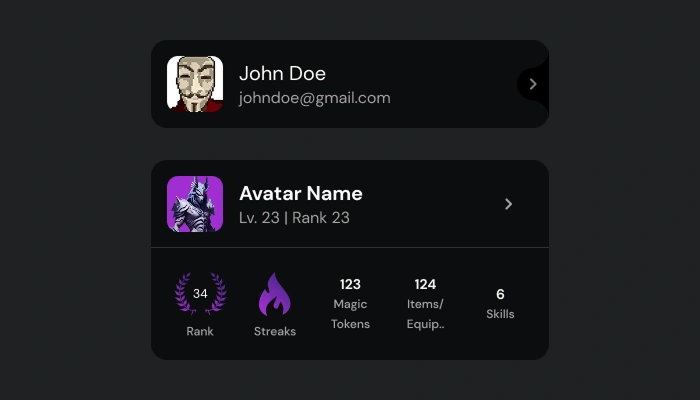
2. Level‑Up Themes & Animations
As you keep progressing, you unlock new themes and animations.
MagicTask injects a dose of novelty into routine chores. Each level‑up refreshes your interface, reminding you that consistent effort leads to tangible rewards.
3. Workspace & Global Leaderboards
You can see the gamified leaderboard spotlight both your personal bests and your standing within the team, creating friendly accountability and a transparent measure of success.
Seeing your name climb higher inspires you—and your colleagues—to keep moving forward.
4. Clean, Minimal Interface
MagicTask boasts a clean interface that strips away non‑essentials so that on launch, you see only your current focus. No distractions, no detours—just a clear path to your successive win.
MagicTask gives you the tools to win today, but building lasting consistency takes a broader playbook to help you every step of the way.
Want More Ways to Stay Consistent?
Level up your long‑term productivity with our eBook, Become the GOAT of Productivity. This is a research‑backed playbook designed to turn momentum into habit. It provides:
- Advanced Mindset Tools: Techniques to rewire your habits and cultivate a growth‑oriented outlook.
- Proven Systems: Ready‑to‑use frameworks for prioritization, goal‑setting, and decision‑making that remove the guesswork.
- Daily Planning Techniques: Customizable templates and rituals—like morning success routines and weekly reviews—to keep you on track without burning out.
By combining MagicTask’s immediate rewards with the eBook’s strategic depth, you’ll not only crush today’s tasks but also build the habits that keep you at peak performance—day after day, quarter after quarter.
Conclusion
Procrastination is a habit that affects almost everyone at some point. But how you handle it will define your success. Your brain is wired to seek comfort before effort.
So, procrastination isn’t a moral failing; it’s an emotional shortcut. But the good news is that you can outsmart it with low‑resistance wins.
By now, you know that:
- Procrastination is driven by emotion, not laziness
- You can prime your brain for action with micro‑steps
- Small actions, repeated consistently, compound into significant progress
So here’s your next step: open MagicTask, choose one small task—maybe something you’d usually put off—move it into your Focus lane, and mark it done. That single checkmark will trigger the very momentum you need to tackle the next.
Know that momentum is built, not found. Start where you are—and let progress pull you forward.
